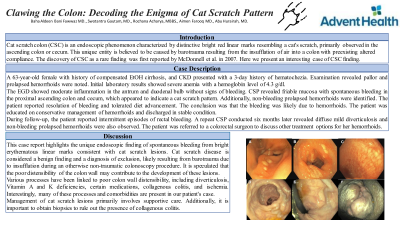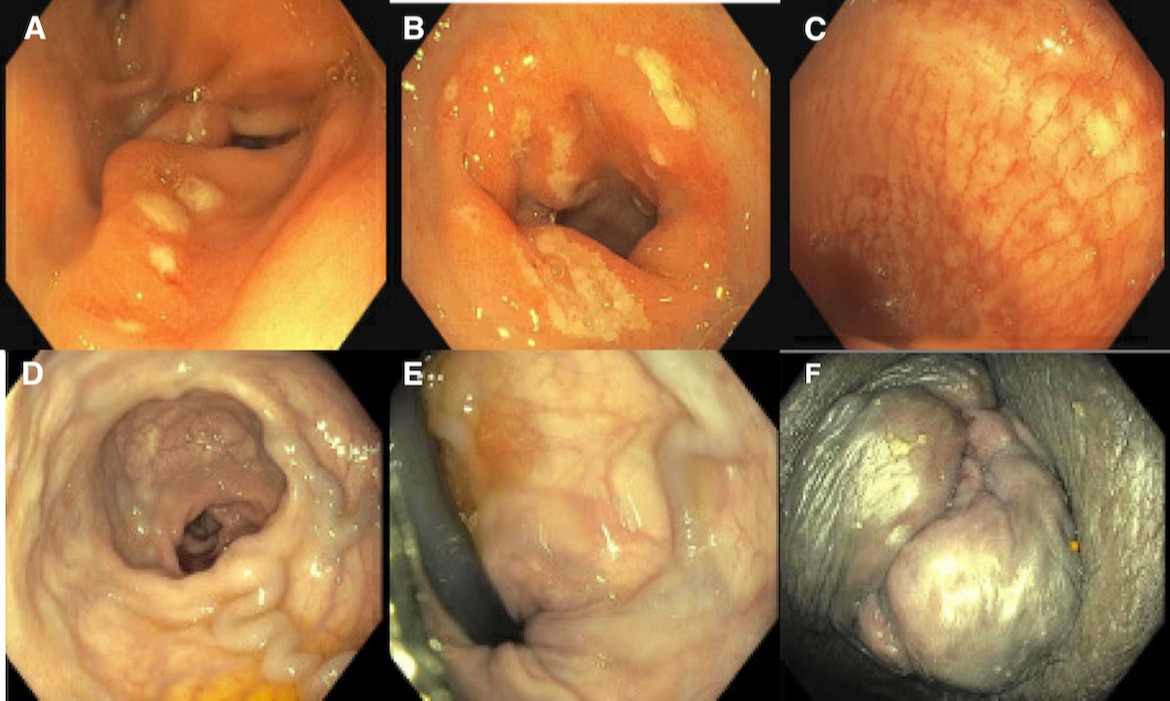Tuesday Poster Session
Category: Colon
P3104 - Clawing the Colon: Decoding the Enigma of Cat Scratch Pattern
Tuesday, October 24, 2023
10:30 AM - 4:00 PM PT
Location: Exhibit Hall

Has Audio

Baha Aldeen Bani Fawwaz, MD
AdventHealth
Orlando, FL
Presenting Author(s)
Baha Fawwaz, MD1, Swotantra Gautam, MD1, Rochana Acharya, MBBS2, Aimen Farooq, MD1, Abu Hurairah, MD1
1AdventHealth, Orlando, FL; 2B.P. Koirala Institute of Health Sciences, Dharan, Dhawalagiri, Nepal
Introduction: Cat scratch colon (CSC) is an endoscopic phenomenon characterized by distinctive bright red linear marks resembling a cat's scratch, primarily observed in the ascending colon or cecum. This unique entity is believed to be caused by barotrauma resulting from the insufflation of air into a colon with preexisting altered compliance. The discovery of CSC as a rare finding was first reported in 2007. Here we present an interesting case of CSC finding.
Case Description/Methods: A 63-year-old female with history of compensated EtOH cirrhosis, and CKD presented with a 3 day history of hematochezia. Examination revealed no abdominal tenderness, but pallor and prolapsed hemorrhoids were noted. Initial laboratory results showed severe anemia with a hemoglobin level of 4.3 g/dl. Vitals and the remaining labs are detailed in Table 1. The patient received blood transfusion and was initiated on pantoprazole and octreotide. She was then prepared for an EGD and colonoscopy (CSP).
The EGD showed moderate inflammation in the antrum and duodenal bulb without signs of bleeding. CSP revealed friable mucosa with spontaneous bleeding in the proximal ascending colon and cecum, which appeared to indicate a cat scratch pattern. Additionally, non-bleeding prolapsed hemorrhoids were identified. The patient reported resolution of bleeding and tolerated diet advancement. The conclusion was that the bleeding was likely due to hemorrhoids. The patient was educated on conservative management of hemorrhoids and discharged in stable condition.
During follow-up, the patient reported intermittent episodes of rectal bleeding. A repeat CSP conducted six months later revealed diffuse mild diverticulosis and non-bleeding prolapsed hemorrhoids were also observed.The histopathology of the colonic mucosa was normal.The patient was referred to a colorectal surgeon to discuss other treatment options for her hemorrhoids.
Discussion: CSC is considered a benign finding and a diagnosis of exclusion, likely resulting from barotrauma. It is speculated that the poor distensibility of the colon wall may contribute to the development of these lesions.
Various processes have been linked to poor colon distensibility, including diverticulosis, deficiencies in vitamins A and K, certain medications, collagenous colitis, and ischemia. Interestingly, many of these processes are present in our patient's case.
Management of cat scratch lesions primarily involves supportive care. Additionally, it is important to obtain biopsies to rule out collagenous colitis.

Disclosures:
Baha Fawwaz, MD1, Swotantra Gautam, MD1, Rochana Acharya, MBBS2, Aimen Farooq, MD1, Abu Hurairah, MD1. P3104 - Clawing the Colon: Decoding the Enigma of Cat Scratch Pattern, ACG 2023 Annual Scientific Meeting Abstracts. Vancouver, BC, Canada: American College of Gastroenterology.
1AdventHealth, Orlando, FL; 2B.P. Koirala Institute of Health Sciences, Dharan, Dhawalagiri, Nepal
Introduction: Cat scratch colon (CSC) is an endoscopic phenomenon characterized by distinctive bright red linear marks resembling a cat's scratch, primarily observed in the ascending colon or cecum. This unique entity is believed to be caused by barotrauma resulting from the insufflation of air into a colon with preexisting altered compliance. The discovery of CSC as a rare finding was first reported in 2007. Here we present an interesting case of CSC finding.
Case Description/Methods: A 63-year-old female with history of compensated EtOH cirrhosis, and CKD presented with a 3 day history of hematochezia. Examination revealed no abdominal tenderness, but pallor and prolapsed hemorrhoids were noted. Initial laboratory results showed severe anemia with a hemoglobin level of 4.3 g/dl. Vitals and the remaining labs are detailed in Table 1. The patient received blood transfusion and was initiated on pantoprazole and octreotide. She was then prepared for an EGD and colonoscopy (CSP).
The EGD showed moderate inflammation in the antrum and duodenal bulb without signs of bleeding. CSP revealed friable mucosa with spontaneous bleeding in the proximal ascending colon and cecum, which appeared to indicate a cat scratch pattern. Additionally, non-bleeding prolapsed hemorrhoids were identified. The patient reported resolution of bleeding and tolerated diet advancement. The conclusion was that the bleeding was likely due to hemorrhoids. The patient was educated on conservative management of hemorrhoids and discharged in stable condition.
During follow-up, the patient reported intermittent episodes of rectal bleeding. A repeat CSP conducted six months later revealed diffuse mild diverticulosis and non-bleeding prolapsed hemorrhoids were also observed.The histopathology of the colonic mucosa was normal.The patient was referred to a colorectal surgeon to discuss other treatment options for her hemorrhoids.
Discussion: CSC is considered a benign finding and a diagnosis of exclusion, likely resulting from barotrauma. It is speculated that the poor distensibility of the colon wall may contribute to the development of these lesions.
Various processes have been linked to poor colon distensibility, including diverticulosis, deficiencies in vitamins A and K, certain medications, collagenous colitis, and ischemia. Interestingly, many of these processes are present in our patient's case.
Management of cat scratch lesions primarily involves supportive care. Additionally, it is important to obtain biopsies to rule out collagenous colitis.

Figure: Images (A+B): EGD findings of moderate inflammation in the antrum (A) and the duodenum (B).
Image (C): Initial CSP findings of cat scratch lesions in the proximal colon.
Images (D+E+F): CSP findings of prolapsed internal and external hemorrhoids.
Image (C): Initial CSP findings of cat scratch lesions in the proximal colon.
Images (D+E+F): CSP findings of prolapsed internal and external hemorrhoids.
Disclosures:
Baha Fawwaz indicated no relevant financial relationships.
Swotantra Gautam indicated no relevant financial relationships.
Rochana Acharya indicated no relevant financial relationships.
Aimen Farooq indicated no relevant financial relationships.
Abu Hurairah indicated no relevant financial relationships.
Baha Fawwaz, MD1, Swotantra Gautam, MD1, Rochana Acharya, MBBS2, Aimen Farooq, MD1, Abu Hurairah, MD1. P3104 - Clawing the Colon: Decoding the Enigma of Cat Scratch Pattern, ACG 2023 Annual Scientific Meeting Abstracts. Vancouver, BC, Canada: American College of Gastroenterology.
